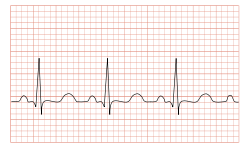Difference between revisions of "Tachycardia"
(Новая страница: «en:Tachycardia ru:Тахикардия справа<b>Tachycardia</b> is a heart rhythm disorder in which three or m…») |
|||
| Line 1: | Line 1: | ||
[[en:Tachycardia]] | [[en:Tachycardia]] | ||
[[ru:Тахикардия]] | [[ru:Тахикардия]] | ||
| − | [[ | + | [[File:Tachycardia.png|right]]<b>Tachycardia</b> is a heart rhythm disorder in which three or more complexes follow one another at a rate of more than 100 contractions per minute. More often they arise as a result of structural damage to the heart. |
In most cases, tachycardia can not cause any other symptoms and complications. But the increased heart rate can seriously disrupt the normal work of the heart and increase the risk of stroke. When the heart contracts too often, the effectiveness of his work reduces, which is accompanied by a decrease in the delivery of oxygen to the organs and the appearance of such symptoms as: shortness of breath, dizziness, chest pain, loss of consciousness. The risk of developing of tachycardia increases in the elderly, which is associated with age-related changes in the heart tissue. Often the propensity to tachycardia is inherited. The complications of tachycardia are associated with its cause and severity and can include serious diseases such as stroke or heart failure. | In most cases, tachycardia can not cause any other symptoms and complications. But the increased heart rate can seriously disrupt the normal work of the heart and increase the risk of stroke. When the heart contracts too often, the effectiveness of his work reduces, which is accompanied by a decrease in the delivery of oxygen to the organs and the appearance of such symptoms as: shortness of breath, dizziness, chest pain, loss of consciousness. The risk of developing of tachycardia increases in the elderly, which is associated with age-related changes in the heart tissue. Often the propensity to tachycardia is inherited. The complications of tachycardia are associated with its cause and severity and can include serious diseases such as stroke or heart failure. | ||
Latest revision as of 12:35, 7 June 2017
Tachycardia is a heart rhythm disorder in which three or more complexes follow one another at a rate of more than 100 contractions per minute. More often they arise as a result of structural damage to the heart.
In most cases, tachycardia can not cause any other symptoms and complications. But the increased heart rate can seriously disrupt the normal work of the heart and increase the risk of stroke. When the heart contracts too often, the effectiveness of his work reduces, which is accompanied by a decrease in the delivery of oxygen to the organs and the appearance of such symptoms as: shortness of breath, dizziness, chest pain, loss of consciousness. The risk of developing of tachycardia increases in the elderly, which is associated with age-related changes in the heart tissue. Often the propensity to tachycardia is inherited. The complications of tachycardia are associated with its cause and severity and can include serious diseases such as stroke or heart failure.

